Publications
Toxic remains: Infrastructural failure in a Ugandan molecular biology lab
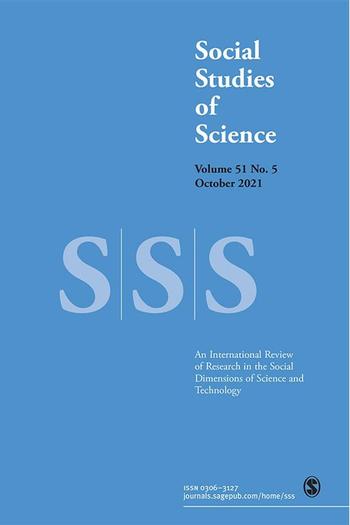
Calkins, Sandra
Appeared in: 2021 - Social Studies of Science 51 (5)
Dieser Artikel verkompliziert die Romantik der infrastrukturellen Improvisation, indem er das Versagen der Infrastruktur beschreibt, durch das Forscher*innen in einem ugandischen Molekularbiologielabor gefährlichen Chemikalien ausgesetzt sind. Um Projektfristen einzuhalten, Karriere zu machen und an transnationalen Kooperationsprojekten teilzunehmen, müssen ugandische Biolog*innen mit ihren Körpern für verfallende oder fehlende Infrastrukturen einspringen. Die ugandischen Biolog*innen verheimlichen solche Opfer vor ihren internationalen wissenschaftlichen Partner*innen und schieben die Schuld auf andere. Eine unklare Schuld ergibt sich gerade aus der Art und Weise, wie Macht in transnationalen wissenschaftlichen Infrastrukturen funktioniert und verteilt ist.
Between the Lab and the Field. Plants and the Affective Atmospheres Of Southern Science
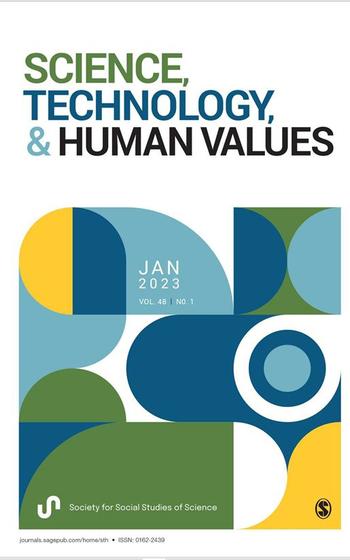
Calkins, Sandra
Appeared in: Science, Technology, & Human Values
In view of persistent global inequalities in scientific knowledge production with clear centers and peripheries, this paper examines a lingering concern for many scientists in the Global South: why is it, at times, so hard to have scientific insights from the South recognized? This paper addresses this big question from within a long-term field immersion in a Ugandan–Australian scientific collaboration in molecular biology. I show how disciplinary hierarchies of value affect the distribution of labor between Uganda and Australia and thematize the role of place and its affective atmospheres that texture the quotidian scientific work in this project. Unsurprisingly, they tend to devalue Ugandan sites and contributions, and turn Uganda into a rather unlikely site for new insights to emerge. However, in spite of doing devalued and outsourced “menial” labor such as fieldwork, Ugandan biologists’ fieldwork involves affective encounters with their experimental banana plants that thereby become differently thinkable. The paper argues that attending to affective atmospheres that infuse research sites offers clues about scientists’ position in global hierarchies and at the same time can help make room for insights that emanate from unexpected places.
The Anatolian High-Mountain Ranges. Plant Diversity Between Two Seas
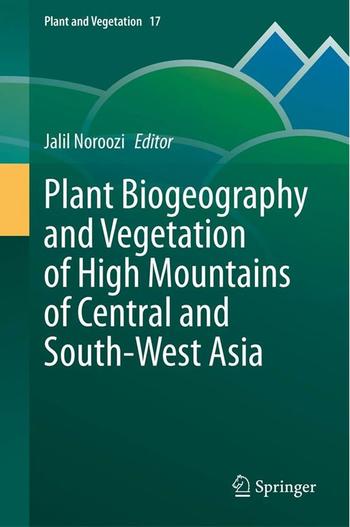
Parolly, Gerald
Appeared in: Noroozi (Ed.) 2020 – Plant Biogeography and Vegetation, Band/Volume 17 ÜBERPRÜFEN
This contribution provides a survey on the high-mountain vegetation of Anatolia, Turkey, covering the West Anatolian Mts., the Taurus mountain system, the Inner Anatolian volcanoes, the East Anatolian highlands and the Black Sea Mts. Due to its location between the Black Sea and the Mediterranean Sea, the intersection of three phytogeographical regions, a highly varied geologic and climatic setting in addition to a dramatic geological past, the plant life of the different Anatolian mountains systems and isolated peaks is amazingly diverse and very rich in endemics. The chapter introduces all important high-mountain ranges, their zonation, major ecosystems, key vegetation types and floristic inventories. Based on a thorough phytogeographic analysis of the high-mountain flora and an evaluation of a wide range of floristic and phylogenetic studies, the diversity patterns of the Anatolian mountain systems and their floristic links to the adjacent areas are reviewed and mapped.
Taxidermy in Motion (not) from a Bird's-eye Perspective. Choreographing Disappearance at the Australian Museum
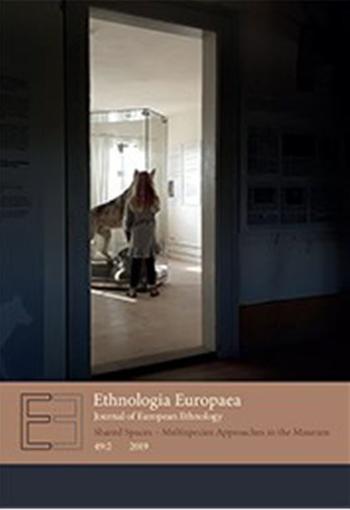
Schmitt, Susanne
Appeared in: 2020 - Ethnologia Europaea 49 (2)
This reflection piece interrogates what a focus on movement can bring to understanding more-than-human relationality in a museum space. It does so by zooming in on choreography and taxidermy as practices that both enable movement and kinesthetic becoming. It focusses on “Send out a Pulse!”, an artistic intervention for the Australian Museum in Sydney. Said piece is a nontraditional, choreographic audio walk made by the author as part of “How to Not be a Stuffed Animal”, an interdisciplinary, artistic-scholarly duo. Following a flightway of birds’ extinction stories, ways to activate response-ability through multispecies movement will be explored.
Writing Planetary Futures. Plants, Loss, and Intersections of STS and Anthropology in Germany
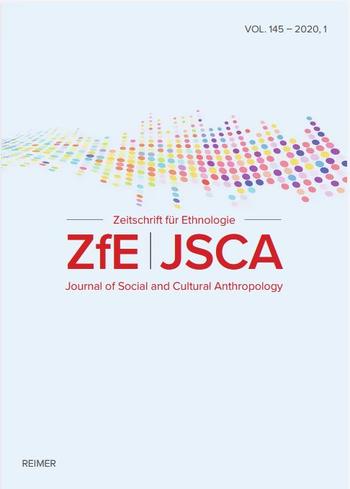
Calkins, Sandra
Appeared in: Zeitschrift für Ethnologie 145(1)
A concern with the environment and contemporary political contestations of environmental crisis animates this paper. This planetary moment is a starting point for my reflections about future trajectories for anthropology (in German-speaking countries) as is my recent ethnographic fieldwork with plant molecular biologists in Uganda. I wrote this paper in the spirit of opening up new conversations. I sketch three promising strands of debate that have a direct bearing on how anthropologists write "planetary futures": 1) the study of nonhuman or more-than-human lives that were long ignored; 2) intellectual stances between hope and loss that relate to our planetary ecological predicament and what to do about it; and 3) intersections of science and technology studies (STS) and anthropology in Germany that are gaining relevance as more anthropologists are grappling with environmental topics and the research of natural scientists.
Lab hands and knowing toxic substances in Uganda
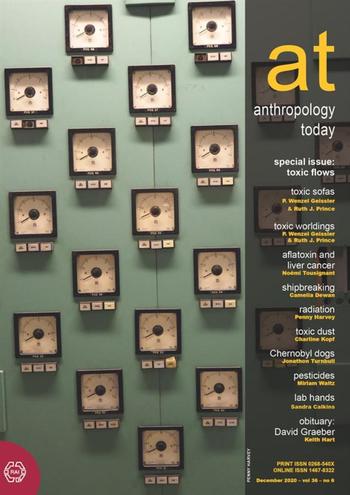
Calkins, Sandra
Appeared in: Anthropology Today 36(6)
How does one know a toxic substance? Perhaps paradoxically, through contact with it, as I show ethnographically from a molecular biology laboratory in Uganda, a site where people routinely handle a range of chemicals, including potentially hazardous toxicants. I analyse an everyday situation in which researchers worked with ethidium bromide, a substance regularly used to stain DNA bands in gels at this Ugandan lab but also in many comparable labs elsewhere. Ethidium bromide is one of the most fear-inspiring chemicals at this lab; it is considered a potent mutagen and thus counts as highly carcinogenic. While the lab has clear safety procedures concerning how to handle this substance correctly, these are often not implemented in a hard-to-control lab setting marked by both material deprivation and a steady flow of unremunerated volunteers who seek to gain practical experience. I show how experienced Ugandan scientists have learned to mitigate their own risk of exposure to ethidium bromide by developing choreographed routines that prevent them from inadvertently touching it. I examine this as a way of ‘handling’ a dangerous substance, developing and habituating skilled movements of hands and bodies that then are passed on to other researchers. It is not an abstract knowledge of a substance's chemical properties that counts here; instead, knowing a toxic substance implies practical routines of handling.
Chemical Dissidents and Vegetal Collaborators
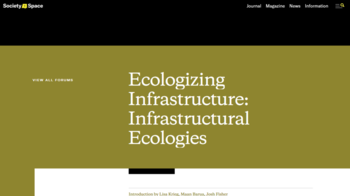
Calkins, Sandra
Appeared in: Barua, Krieg et al. (Ed.) 2020 – Ecologizing infrastructure
When writing about infrastructures do we need to decide a priori whose agency – whether human, animal, plant or thing – needs attending to?
Provenienzforschung im Kontext botanischer Sammlungen

Grotz, Kathrin; Rahemipour, Patricia
Appeared in: MuseumsJournal Ausgabe 01/2019
Health as Growth. Bananas, Humanitarian Biotech, and Human-Plant Histories in Uganda
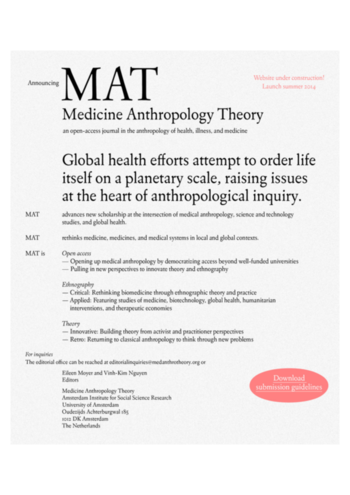
Calkins, Sandra
Appeared in: Medicine Anthropology Theory 6(3)
What notions of health and proper nutrition are articulated in the use and promotion of agricultural biotechnology in the global South? What future trajectories for health do they envision? Experiments with genetically modified bananas in Uganda use the fruit as a vehicle to achieve public health goals. This work in plant science understands itself as humanitarian, drawing on specific notions of health and its opposite: the deficient health of humans and plants. Instead of thinking about improved health through bananas, which implies an instrumental relationship to plants, I connect this high-tech effort to a way of thinking with the banana plant in central Uganda that highlights the entanglement of human and plant growth. Expanding our thinking about health with plants and the gardens where they grow relocates the production of health to sites that still seldom figure in medical anthropology and helps reconceptualize what one takes growth to be and what relations can sustain cross-species thriving.
Allgemeines zum Bestimmen und Sammeln von Pflanzen
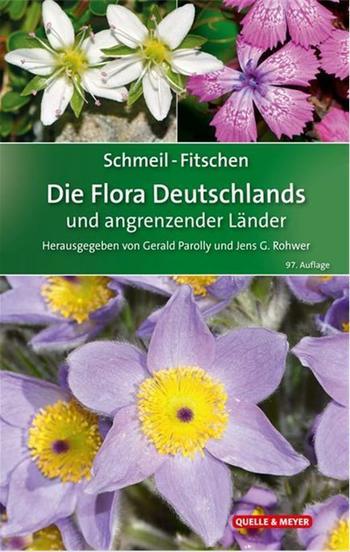
Parolly, Gerald
Appeared in: Parolly, Rohwer (Hg.) 2019 – Die Flora Deutschlands und angrenzender Länder
Botanical Dioramas - Just Beautiful?
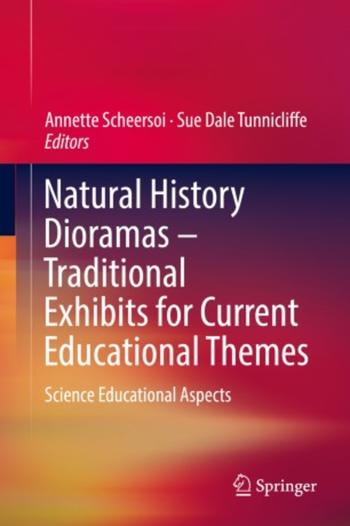
Grotz, Kathrin
Appeared in: Scheersoi, Tunnicliffe (Ed.) 2019 – Natural History Dioramas - Traditional Exhibits for Current Educational Themes
For almost 50 years, the Botanical Museum in Berlin has been displaying sixteen small dioramas, each of them showing a different vegetation type. These dioramas are very specific in their idealized presentation of vegetation types which can be found around the world and are unique with respect to their downscaled size of 1:10 or 1:20. Most notable is the exclusive focus on plants and their diversity in the specific habitat on display. Artfully elaborated by various artists in the 1950s and 1960s, today these botanical jewels both challenge and enrich our efforts to communicate vegetation changes and threats. The contribution focuses both on the genesis and scientific background of these elaborate objects, as well as on their potential and delimitations as contemporary agents of knowledge transfer in science.
Population (What is It Good For?)
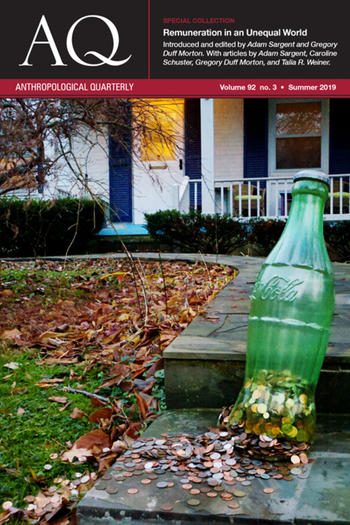
Calkins, Sandra; Zoanni, Tyler
Appeared in: Anthropological Quarterly 92(3)
Allgemeines zum Aufbau und Inhalt der Flora. Grundbegriffe, Leitlinien und Konzepte

Parolly, Gerald
Appeared in: Parolly, Rohwer (Hg.) 2019 – Die Flora Deutschlands und angrenzender Länder
Tracing the Flow of Genetic Resources in our Collections. How the Nagoya Challenge Supports the Integration of our Collection Data
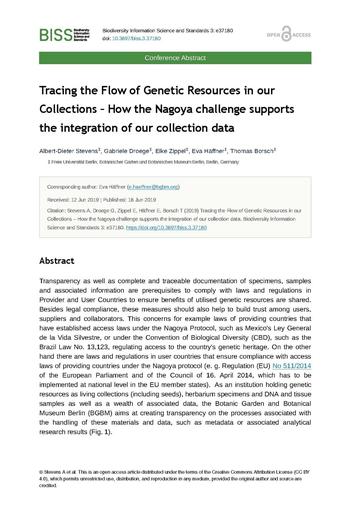
Stevens, Albert-Dieter; Droege, Gabriele; Zippel, Elke; Häffner, Eva; Borsch, Thomas
Appeared in: BISS (Biodiversity Information Science and Standards) Vol. 3
Transparency as well as complete and traceable documentation of specimens, samples and associated information are prerequisites to comply with laws and regulations in Provider and User Countries to ensure benefits of utilised genetic resources are shared. Besides legal compliance, these measures should also help to build trust among users, suppliers and collaborators. This concerns for example laws of providing countries that have established access laws under the Nagoya Protocol, such as Mexico's Ley General de la Vida Silvestre, or under the Convention of Biological Diversity (CBD), such as the Brazil Law No. 13,123, regulating access to the country's genetic heritage. On the other hand there are laws and regulations in user countries that ensure compliance with access laws of providing countries under the Nagoya protocol (e. g. Regulation (EU) No 511/2014 of the European Parliament and of the Council of 16. April 2014, which has to be implemented at national level in the EU member states). As an institution holding genetic resources as living collections (including seeds), herbarium specimens and DNA and tissue samples as well as a wealth of associated data, the Botanic Garden and Botanical Museum Berlin (BGBM) aims at creating transparency on the processes associated with the handling of these materials and data, such as metadata or associated analytical research results (Fig. 1).
Vorwort

Parolly, Gerald
Appeared in: Parolly, Rohwer (Hg.) 2019 – Die Flora Deutschlands und angrenzender Länder
Infrastructures of Citizenship in India. Review Essay
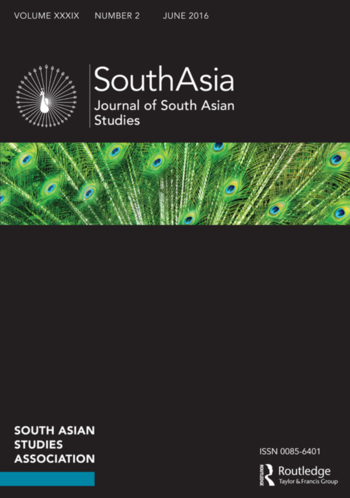
Calkins, Sandra
Appeared in: South Asia - Journal of South Asian Studies 42(4)
In recent years, literature on infrastructure has empirically expanded and conceptually broadened in the social sciences and the humanities to a point where nearly anything can be called an infrastructure. Has it merely become a replacement for other established terms, such as actor–network, assemblage or technical system? Certainly, social theory offers a range of notions other than infrastructure that can capture the dispersed nature of agency as well as the importance and the intransigence of materiality for social practices. Nonetheless, the three books on India under review here underline the strengths of infrastructure as an analytical lens on broader political and socio-economic processes. Infrastructure is not only an analytical term that can be used to reflect on some dimensions of highly-organised social practices, it is also an unstable ethnographic object that can by equal measure animate technocratic visions of social engineering and liberal imaginations of free circulation, while enabling new forms of social action and unequal possibilities of participation and belonging. The three anthropologists, Simanti Dasgupta, Nikhil Anand and Leo Coleman, show—in different ways, different ethnographic contexts and in three different Indian cities—that water and power infrastructures tend to background politics and foreground technological issues, yet ceaselessly do political and moral work all the way to their smallest pieces and levels of interaction.
Bemerkungen zur Flora und Vegetation des Gebiets

Parolly, Gerald
Appeared in: Parolly, Rohwer (Hg.) 2019 – Die Flora Deutschlands und angrenzender Länder
The High-Mountain Flora and Vegetation of the Western and Central Taurus Mts. (Turkey) in the Times of Climate Change
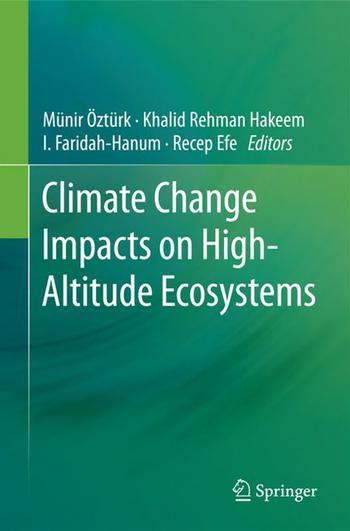
Parolly, Gerald
Cham: Springer VS | 2015
Appeared in: Öztürk, Münir; Reman Hakeem, Khalid; Faridah-Hanum, I.; Efe, Recep (ed.) - Climate Change Impacts on High-Altitude Ecosystems
This contribution reviews in a first part the knowledge on the diverse high-mountain flora and vegetation of the Taurus Mts. and deals with general diversity patterns in the Western and Central Taurus, the zonation of the vegetation belts, and the major syntaxa....
Botanical Gardens and their Role in Ex Situ Conservation and Research
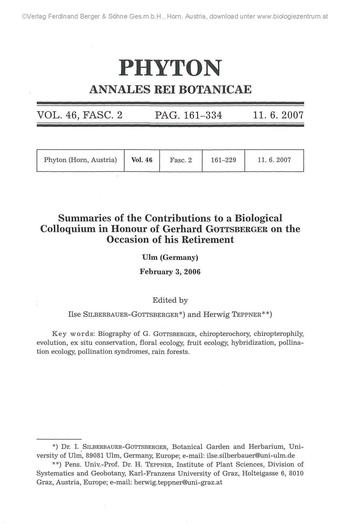
Stevens, Albert-Dieter
Appeared in: Phyton - Annales Rei Botanicae 46(2)